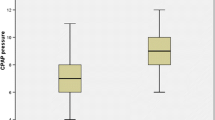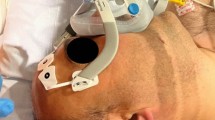Abstract
Purpose
Review drug-induced sleep endoscopy (DISE) findings in children with Prader-Willi syndrome (PWS) and correlate the patterns of airway collapse with apnea-hypopnea index (AHI) and body mass index (BMI).
Methods
A total of nine children with PWS underwent DISE. DISE findings were recorded using the VOTE classification system. The relationship between different patterns of airway collapse with AHI and BMI was analyzed.
Results
The majority of children with PWS were found to have multilevel obstruction (six out of nine children, 66.6 %). The velum was the most common site of obstruction (nine out of nine children, 100 %). All of the patients had positional obstructive sleep apnea (OSA). Patients with partial or complete anterior-posterior tongue base collapse were associated with a significantly higher AHI (P = 0.016) compared to patients with no anterior-posterior tongue base collapse. Apart from tongue base collapse, no other patterns of airway collapse showed a consistent association with AHI in our results. No patterns of airway collapse showed a significant association with BMI in our study.
Conclusions
In our study, partial or complete anterior-posterior tongue base collapse was associated with higher AHI values in children with PWS. Therefore, careful attention should be addressed to the management of tongue base collapse. Positional therapy could be a potential treatment for patients with PWS since it may alleviate the severity of tongue base collapse.
Similar content being viewed by others
References
Cassidy SB, Schwartz S, Miller JL, Driscoll DJ (2012) Prader-Willi syndrome. Genet Med 14:10–26
Cohen M, Hamilton J, Narang I (2014) Clinically important age-related differences in sleep related disordered breathing in infants and children with Prader-Willi syndrome. PLoS One 9:e101012
Miller J, Wagner M (2013) Prader-Willi syndrome and sleep-disordered breathing. Pediatr Ann 42:200–204
Nixon GM, Brouillette RT (2002) Sleep and breathing in Prader-Willi syndrome. Pediatr Pulmonol 34:209–217
Sedky K, Bennett DS, Pumariega A (2014) Prader Willi syndrome and obstructive sleep apnea: co-occurrence in the pediatric population. J Clin Sleep Med 10:403–409
Nixon GM, Rodda CP, Davey MJ (2011) Longitudinal association between growth hormone therapy and obstructive sleep apnea in a child with Prader-Willi syndrome. J Clin Endocrinol Metab 96:29–33
DeMarcantonio MA, Darrow DH, Gyuricsko E, Derkay CS (2010) Obstructive sleep disorders in Prader-Willi syndrome: the role of surgery and growth hormone. Int J Pediatr Otorhinolaryngol 74:1270–1272
Bizzarri C, Rigamonti AE, Luce A, et al. (2010) Children with Prader-Willi syndrome exhibit more evident meal-induced responses in plasma ghrelin and peptide YY levels than obese and lean children. Eur J Endocrinol 162:499–505
Camfferman D, Lushington K, O’Donoghue F, Doug McEvoy R (2006) Obstructive sleep apnea syndrome in Prader-Willi syndrome: an unrecognized and untreated cause of cognitive and behavioral deficits? Neuropsychol Rev 16:123–129
Crockett DJ, Ahmed SR, Sowder DR, Wootten CT, Chinnadurai S, Goudy SL (2014) Velopharyngeal dysfunction in children with Prader-Willi syndrome after adenotonsillectomy. Int J Pediatr Otorhinolaryngol 78:1731–1734
Meyer SL, Splaingard M, Repaske DR, Zipf W, Atkins J, Jatana K (2012) Outcomes of adenotonsillectomy in patients with Prader-Willi syndrome. Arch Otolaryngol Head Neck Surg 138:1047–1051
Tanna N, Choi SS (2009) Efficacy and safety of adenotonsillectomy for pediatric obstructive sleep apnea in Prader-Willi syndrome. Ann Otol Rhinol Laryngol 118:267–269
Pavone M, Paglietti MG, Petrone A, Crino A, De Vincentiis GC, Cutrera R (2006) Adenotonsillectomy for obstructive sleep apnea in children with Prader-Willi syndrome. Pediatr Pulmonol 41:74–79
Kezirian EJ, Hohenhorst W, de Vries N (2011) Drug-induced sleep endoscopy: the VOTE classification. Eur Arch Otorhinolaryngol 268:1233–1236
Vroegop AV, Vanderveken OM, Boudewyns AN, et al. (2014) Drug-induced sleep endoscopy in sleep-disordered breathing: report on 1,249 cases. Laryngoscope 124:797–802
Koo SK, Choi JW, Myung NS, Lee HJ, Kim YJ, Kim YJ (2013) Analysis of obstruction site in obstructive sleep apnea syndrome patients by drug induced sleep endoscopy. Am J Otolaryngol 34:626–630
Ulualp SO, Szmuk P (2013) Drug-induced sleep endoscopy for upper airway evaluation in children with obstructive sleep apnea. Laryngoscope 123:292–297
Ravesloot MJ, de Vries N (2011) One hundred consecutive patients undergoing drug-induced sleep endoscopy: results and evaluation. Laryngoscope 121:2710–2716
Wong CP, Ng DK, Ma TM, Chau C, Chow PY, Kwok KL (2010) Improvement in quality of life after adenotonsillectomy in a child with Prader Willi syndrome. Sleep Breath 14:167–170
Donnelly LF, Shott SR, LaRose CR, Chini BA, Amin RS (2004) Causes of persistent obstructive sleep apnea despite previous tonsillectomy and adenoidectomy in children with down syndrome as depicted on static and dynamic cine MRI. AJR Am J Roentgenol 183:175–181
Donaldson JD, Redmond WM (1988) Surgical management of obstructive sleep apnea in children with down syndrome. J Otolaryngol 17:398–403
Kotagal S, Gibbons VP, Stith JA (1994) Sleep abnormalities in patients with severe cerebral palsy. Dev Med Child Neurol 36:304–311
Durr ML, Meyer AK, Kezirian EJ, Rosbe KW (2012) Drug-induced sleep endoscopy in persistent pediatric sleep-disordered breathing after adenotonsillectomy. Arch Otolaryngol Head Neck Surg 138:638–643
Victores AJ, Hamblin J, Gilbert J, Switzer C, Takashima M (2014) Usefulness of sleep endoscopy in predicting positional obstructive sleep apnea. Otolaryngol Head Neck Surg 150:487–493
Permut I, Diaz-Abad M, Chatila W, et al. (2010) Comparison of positional therapy to CPAP in patients with positional obstructive sleep apnea. J Clin Sleep Med 6:238–243
Vroegop AV, Vanderveken OM, Wouters K, et al. (2013) Observer variation in drug-induced sleep endoscopy: experienced versus nonexperienced ear, nose, and throat surgeons. Sleep 36:947–953
Kezirian EJ, White DP, Malhotra A, Ma W, McCulloch CE, Goldberg AN (2010) Interrater reliability of drug-induced sleep endoscopy. Arch Otolaryngol Head Neck Surg 136:393–397
Rodriguez-Bruno K, Goldberg AN, McCulloch CE, Kezirian EJ (2009) Test-retest reliability of drug-induced sleep endoscopy. Otolaryngol Head Neck Surg 140:646–651
Rabelo FA, Kupper DS, Sander HH, Fernandes RM, Valera FC (2013) Polysomnographic evaluation of propofol-induced sleep in patients with respiratory sleep disorders and controls. Laryngoscope 123:2300–2305
Capasso R, Rosa T, Tsou, DY et al. (2016) Variable findings for drug-induced sleep endoscopy in obstructive sleep apnea with propofol versus dexmedetomidine. Otolaryngol Head Neck Surg 154(4):765–770
Lin AC, Koltai PJ (2012) Sleep endoscopy in the evaluation of pediatric obstructive sleep apnea. Int J Pediatr 2012:576719
Yoon BW, Hong JM, Hong SL, Koo SK, Roh HJ, Cho KS (2016) A comparison of dexmedetomidine versus propofol during drug-induced sleep endoscopy in sleep apnea patients. Laryngoscope 126:763–767
Author information
Authors and Affiliations
Corresponding author
Ethics declarations
Ethical approval
All procedures performed in studies involving human participants were in accordance with the ethical standards of the institutional and/or national research committee and with the 1964 Helsinki Declaration and its later amendments or comparable ethical standards.
Conflict of interest
All authors certify that they have no affiliations with or involvement in any organization or entity with any financial interest (such as honoraria; educational grants; participation in speakers’ bureaus; membership, employment, consultancies, stock ownership, or other equity interest; and expert testimony or patent-licensing arrangements) or nonfinancial interest (such as personal or professional relationships, affiliations, knowledge, or beliefs) in the subject matter or materials discussed in this manuscript.
Funding
No funding was received for this research.
Informed consent
Informed consent was obtained from all individual participants included in the study.
Rights and permissions
About this article
Cite this article
Lan, MC., Hsu, YB., Lan, MY. et al. Drug-induced sleep endoscopy in children with Prader-Willi syndrome. Sleep Breath 20, 1029–1034 (2016). https://doi.org/10.1007/s11325-016-1338-8
Received:
Revised:
Accepted:
Published:
Issue Date:
DOI: https://doi.org/10.1007/s11325-016-1338-8




